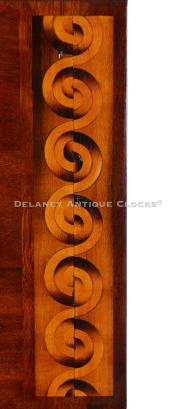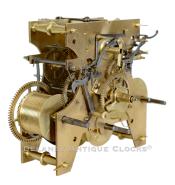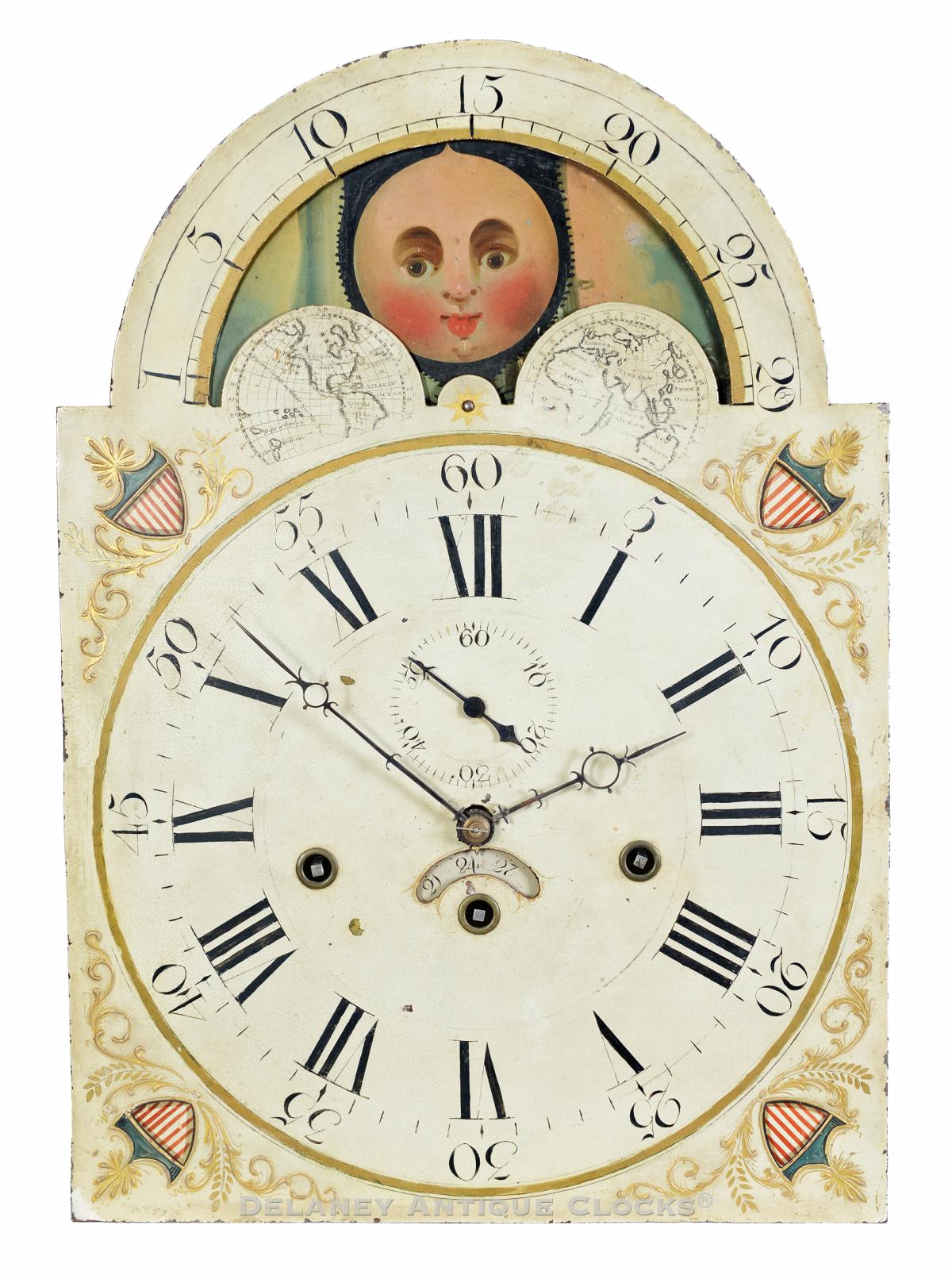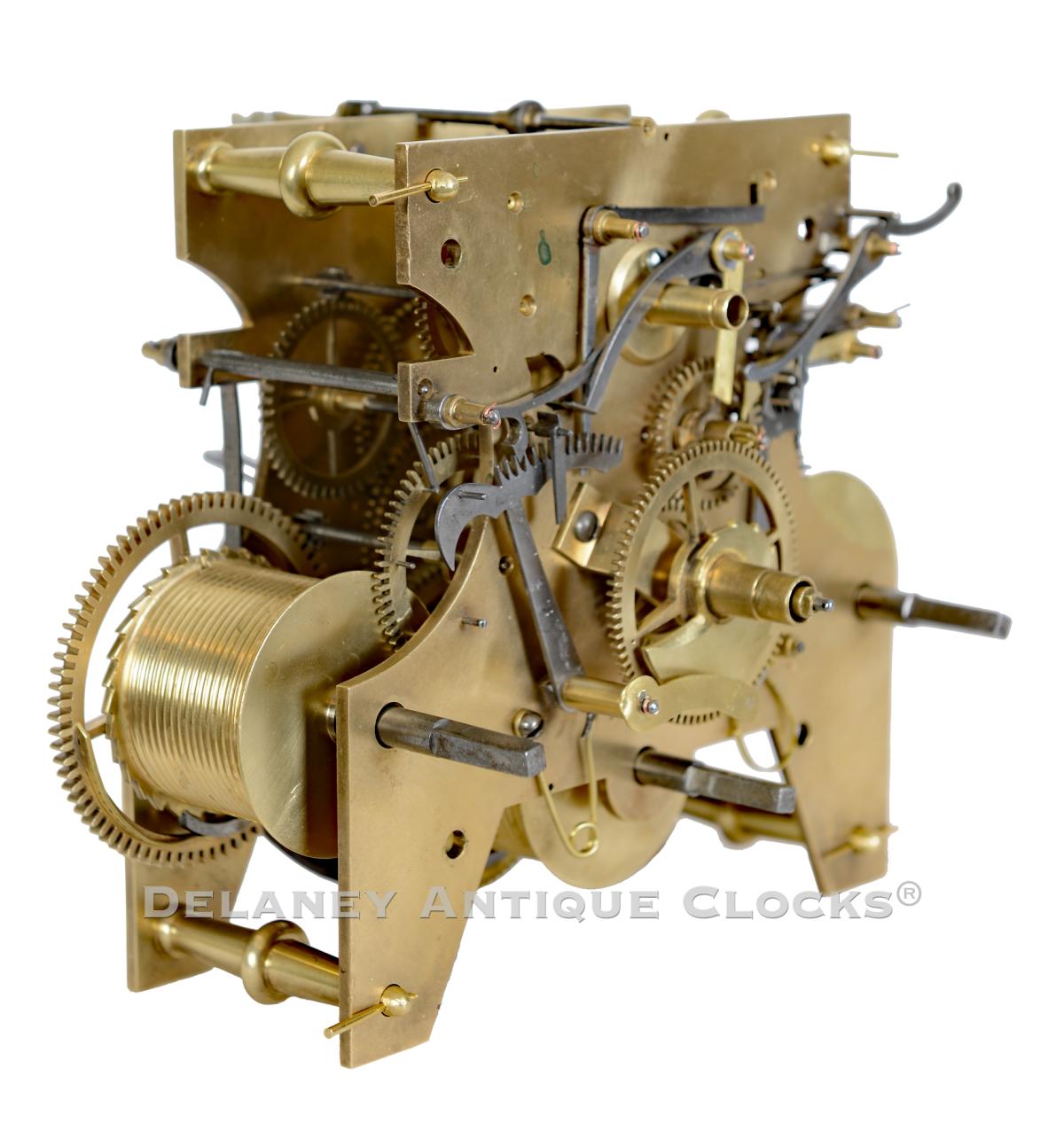This clock, a Vermont masterpiece, is attributed to Lord & Goddard of Rutland, Vermont. It represents the best of what was produced in Vermont during the Federal era. 224089.
This clock represents the BEST of what was produced in Vermont during the Federal era. This superb inlaid mahogany-cased tall clock features a painted lunar dial and three-train quarter-striking movement. Its complex cabinet is as intricate as the finest high-style New York and New Jersey forms. Its design exudes a formality that sets it apart. The mahogany case features five large decorative panels, lunette inlay, and holly inlay patterns. This commanding clock is a standout in its category.
This exceptional example stands on nicely shaped flared French feet. These are an excellent form and smoothly transition into a singular drop-center apron. A banding of cross-banded veneer delineates the feet from the base. A line of inlay segments the base panel into two panels. Both panels, designed with ovolo corners, feature a vertical orientation. Broad cross-banding framed by an additional light line inlay frames the featured figured mahogany panels.
The waist section is long. The three additional panels are found here, decorating the waist. The center panel serves double duty as a door concealing the pendulum and three drive weights. This door features the formatting of the two base panels. The mahogany veneer exhibits fantastic color variations. Additional panels are located at both ends of the door. They are designed with a horizontal orientation and feature a lively crotch selection of birch. These honey-toned panels are exuberantly figured. The color contrasts with the mahogany veneers used in the case construction.
Smaller rectangular panels are positioned at both ends of the smoothly turned quarter columns. These are vertically oriented with a lunette inlay, which has been described as a lavish inlay detail that is a visual feast. The pattern has two opposing runs of double, circle sand-shaped lunettes. The scorched areas provide visual depth to the pattern. These runs are positioned so that they combine to form a vine structure. The quarter columns terminate in brass quarter capitals.
The bonnet or hood features a delicate and beautiful swan's neck pediment. The horns are delicately formed and terminate in inlaid pinwheels of alternating shades of wood. The front facade is also complex. The center panel features an oval of crotch birchwood. The outer corners are decorated with crotch mahogany veneers. Three brass finials are mounted on the front of the case. The two located outside the case are on reeded plinths. Two wooden turned finials in the form of urns are on the back corners. Reeded bonnet columns flank the arched bonnet door. The side panels feature glazed oval-shaped windows. The back styles are reeded. The door frame is lined inlaid. This bonnet door opens to access the painted dial.
The painted dial is mounted to the movement with a false plate. The spandrel areas are decorated with fanciful gesso patterns and American Shields. The time track is formatted in the traditional Roman-style numerals, marking the hours, and Arabic numerals are used for each five-minute marker. A calendar and seconds bit are in the conventional locations. A moon phase mechanism or lunar calendar is located in the arch.
The movement, a three-train or quarter-striking wonder, is a testament to the Clockmaker's skill. The clock's petite sonneire sequence provides an unusual sound for a tall clock of this period. The movement employs a rack-and-snail striking arrangement to strike each hour on the hour on a bell mounted to the backplate. On the quarter hours, it strikes a progressive "bim-bam" sequence on the same bell. Each blow is struck with its own hammer, one of three in total. On the first quarter hour, it strikes two blows on the bell. On the half-hour, it will strike four blows. On the three-quarter hour, it performs six blows. An added feature is that pulling the repeat cord inside the case will strike the hour and then the appropriate bim-bams for the quarter-hour position of the minute hand. The works are constructed in brass, a mark of quality. Four distinctively shaped pillars support the two shaped brass plates. The pillars, composed of tapered cones that swell towards the middle, terminate at a robust center ring. These posts are found on other Lord & Goddard signed clocks. Hardened steel shafts support the polished steel pinions, brass gearing, and recoil escapement. The three winding drums are grooved. The weight-driven movement is designed to run for eight days on a full wind.
Lord & Goddard made this clock circa 1806.
We have recorded a small number of tall-case clocks signed by the Lord & Goddard partnership. The numbers known to date include 72, 75, 87, 95, 97, 98, 111, and 113.
This impressive clock stands approximately 8 feet 3 inches tall, making it a striking addition to any space. Its grand size will surely make a statement. It is 22.5 inches wide and 10.5 inches deep, providing a substantial presence.
Inventory number 224089.
The partnership of Lord & Goddard was first advertised in the Rutland Herald on July 7, 1997. Their shop was located a few rods north of the Rutland Court House just opposite Messrs Pomeroy & Hooker’s store. At this location, they advertised the manufacture of musical clocks and most kinds of gold and silverware. In 1800, they moved approximately 15 rods northwest of the Court House into the shop formerly occupied by Storer & Wilmont. The Lord & Goddard’s partnership lasted approximately eight years and was dissolved on April 26, 1805. A notice was placed in the Rutland Herald on this date. They stayed close friends as their families remained involved in each other’s lives.
Benjamin Lord was born in Norwich, Connecticut, on October 10, 1770, the son of Ebenezer and Temperance (Edgerton). He was first listed as a silversmith in 1793 when he advertised in the Western Star in Pittsfield, Massachusetts, opposite the meeting house on the road to Lanesborough in 1796. Silver spoons are known with his stamp. It is recorded that in 1797, Benjamin moved into Rutland, Vermont, and was there before Goddard moved to town. He began working as a silversmith and watchmaker and, within a few short months, formed a partnership with the newly arrived Nichols Goddard. Benjamin married Fanny Buell in Coventry, Connecticut, on January 28, 1799. Together, they had at least six children while putting roots down in this Rutland. Benjamin became involved with public affairs and served as town clerk in 1803 - 1813 and again in 1815 - 1826. He was a Captain in the local militia. In 1808, he is thought to have trained his nephew John Bliss as a clockmaker. Bliss became a well-documented chronometer maker in New York. Benjamin died on April 23, 1843, in Athens, Georgia.
Nichols Goddard was born the son of Nathan and Martha (Nichols) Goddard in Shrewsbury, Massachusetts, on October 4, 1773. It is thought that he learned clockmaking from his second cousin, Luther Goddard, who was also in Shrewsbury. Luther was trained by his cousin, our country’s most famous clockmaker, Simon Willard of Grafton, in 1778. Luther is often credited with making the first watch in America. Nichols moved away and is listed as working in Northampton, Massachusetts, from 1794 through 1797. A diary entry from 1795 states that as a journeyman, Nichols made movements for his father Luther Goddard, Gardner Parker of Westborough, Isaac Gere of Northampton, Massachusetts, and for a man identified as “Ingalls,” who is also in Northampton. In June of 1797, Goddard moved north to Rutland, Vermont. At this time, the period of 1770 through about 1825, the state of Vermont enjoyed unprecedented population growth. In Rutland, Goddard formed a partnership with a silversmith who was originally from Norwich, Connecticut, and more recently Pittsfield, Massachusetts. His name was Benjamin Lord. In September of 1798, Nichols returned to Northampton to marry Charity White. She was the daughter of Job White (Clockmaker) and Charity Chapin. They returned to Rutland and had seven children together. When the Lord and Goddard partnership ended, Nichols continued making clocks under his name until he died in 1823.
Nichols also involved himself in public affairs. In 1800, he was appointed Town Clerk of Rutland. He also served as Town Treasurer from 1805 - 1807. He received the commission of Captain in the militia. He was also very active in the Masonic lodge. In 1802, he was elected Grand Junior Deacon of the Grand Masonic Lodge of Vermont, and from 1804 through 1810, he served as Grand Senior Warden.
Nichols died in Rutland on September 23, 1823.
The craftsmanship of Lord & Goddard's clocks, a testament to their skill and dedication, is a source of admiration. There are about a dozen clocks signed by Nichols Goddard or signed Lord & Goddard. A fine example signed Lord & Goddard No. 124, is located in the Sheldon Museum. A musical example, signed Nichols Goddard, is in the collection of The Bennington Museum. The Rutland Historical Society was given Nichols Goddard Number 150 in 1996. They also own number 106, which has a repainted dial. Each of these clocks, a unique blend of functionality and beauty, is a testament to the enduring legacy of Lord & Goddard's craftsmanship.
The tall case clocks signed by Lord & Goddard that have been found to date have the following numbers recorded: 72, 75, 87, 95, 97, 98, 106, 111, 112, and 113. Tall clocks signed by Nichols only include 118, 124, 125, 144, and 150.


















